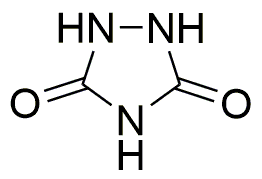Urazole is widely utilized in research focused on:
- Agricultural Chemistry: It serves as a precursor in the synthesis of various agrochemicals, enhancing crop protection and yield. Its ability to inhibit specific enzymes makes it valuable in developing herbicides and fungicides.
- Pharmaceutical Development: Urazole derivatives are explored for their potential as anti-inflammatory and analgesic agents, providing a foundation for new drug formulations that can improve patient outcomes.
- Polymer Science: It is used in the production of specialty polymers and resins, contributing to materials that exhibit enhanced thermal stability and mechanical properties, ideal for high-performance applications.
- Analytical Chemistry: Urazole is employed as a reagent in various analytical techniques, aiding in the detection and quantification of specific compounds in complex mixtures, which is crucial for quality control in manufacturing.
- Biochemistry: It plays a role in biochemical research, particularly in studying metabolic pathways and enzyme interactions, helping researchers understand disease mechanisms and develop targeted therapies.
General Information
Properties
Safety and Regulations
Applications
Urazole is widely utilized in research focused on:
- Agricultural Chemistry: It serves as a precursor in the synthesis of various agrochemicals, enhancing crop protection and yield. Its ability to inhibit specific enzymes makes it valuable in developing herbicides and fungicides.
- Pharmaceutical Development: Urazole derivatives are explored for their potential as anti-inflammatory and analgesic agents, providing a foundation for new drug formulations that can improve patient outcomes.
- Polymer Science: It is used in the production of specialty polymers and resins, contributing to materials that exhibit enhanced thermal stability and mechanical properties, ideal for high-performance applications.
- Analytical Chemistry: Urazole is employed as a reagent in various analytical techniques, aiding in the detection and quantification of specific compounds in complex mixtures, which is crucial for quality control in manufacturing.
- Biochemistry: It plays a role in biochemical research, particularly in studying metabolic pathways and enzyme interactions, helping researchers understand disease mechanisms and develop targeted therapies.
Documents
Safety Data Sheets (SDS)
The SDS provides comprehensive safety information on handling, storage, and disposal of the product.
Product Specification (PS)
The PS provides a comprehensive breakdown of the product’s properties, including chemical composition, physical state, purity, and storage requirements. It also details acceptable quality ranges and the product's intended applications.
Certificates of Analysis (COA)
Search for Certificates of Analysis (COA) by entering the products Lot Number. Lot and Batch Numbers can be found on a product’s label following the words ‘Lot’ or ‘Batch’.
*Catalog Number
*Lot Number
Certificates Of Origin (COO)
This COO confirms the country where the product was manufactured, and also details the materials and components used in it and whether it is derived from natural, synthetic, or other specific sources. This certificate may be required for customs, trade, and regulatory compliance.
*Catalog Number
*Lot Number
Safety Data Sheets (SDS)
The SDS provides comprehensive safety information on handling, storage, and disposal of the product.
DownloadProduct Specification (PS)
The PS provides a comprehensive breakdown of the product’s properties, including chemical composition, physical state, purity, and storage requirements. It also details acceptable quality ranges and the product's intended applications.
DownloadCertificates of Analysis (COA)
Search for Certificates of Analysis (COA) by entering the products Lot Number. Lot and Batch Numbers can be found on a product’s label following the words ‘Lot’ or ‘Batch’.
*Catalog Number
*Lot Number
Certificates Of Origin (COO)
This COO confirms the country where the product was manufactured, and also details the materials and components used in it and whether it is derived from natural, synthetic, or other specific sources. This certificate may be required for customs, trade, and regulatory compliance.


